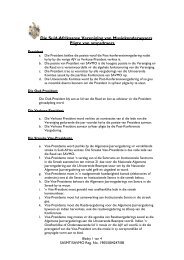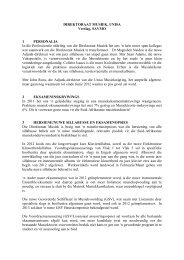2006 Edition 2 (Issue 144) - Sasmt-savmo.org.za
2006 Edition 2 (Issue 144) - Sasmt-savmo.org.za
2006 Edition 2 (Issue 144) - Sasmt-savmo.org.za
Create successful ePaper yourself
Turn your PDF publications into a flip-book with our unique Google optimized e-Paper software.
The six volumes of Jazz<br />
Sessions by Faber Music<br />
are the result of a collaboration<br />
between Alexander<br />
L’Estrange (composer, arranger,<br />
jazz double bass<br />
player and jazz examiner<br />
for the ABRSM) and<br />
Tom Pilling (composer,<br />
jazz pianist and teacher).<br />
Each book spans a host<br />
of jazz idioms including<br />
blues, swing, Latin and<br />
gospel. Included in the series are publications for piano,<br />
violin, flute, clarinet, alto saxophone and trumpet<br />
— all with CD backing. The arrangements and compositions<br />
have second, extended versions that are ideal<br />
for improvisation, and are suitable for the intermediate<br />
level (grades 4-5). The pieces are ideal preparation for<br />
the ABRSM jazz exams. Faber also has more jazz music<br />
available for piano (grade 3-6), as well as Progressive<br />
Jazz Studies for flute, clarinet, saxophone, trumpet and<br />
trombone — all for the intermediate level. The Groove<br />
Lab series of pieces with CD for keyboard, flute, clarinet,<br />
alto saxophone and trumpet are for grades 3-4.<br />
www.fabermusic.com<br />
South African Music Teacher |<strong>144</strong> | November <strong>2006</strong><br />
r e v i e w s ~ r e s e n s i e s<br />
The Universal <strong>Edition</strong><br />
series of “Easy Blue …” for<br />
clarinet, flute, trumpet<br />
and other instruments<br />
contains the first step<br />
to the blues for aspiring<br />
young jazz soloist and<br />
forms the ideal stepping<br />
stone to the more advanced “Blue …” series. James Rae’s<br />
original solo pieces with piano accompaniment serve as<br />
an introduction to this popular genre to players of an<br />
elementary level. Chord symbols are introduced in the<br />
accompaniment to enable the pianist to improvise.<br />
www.universaledition.com




